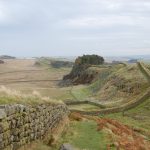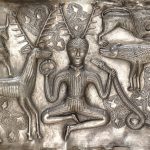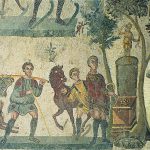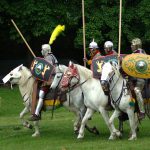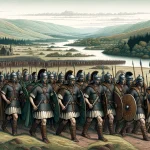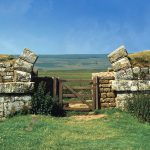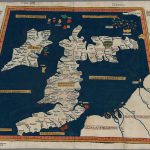Wroxeter (Viroconivm Cornoviorum) Roman Settlement
Aqueduct and British Civita
The Roman town of Viroconium Cornoviorum was situated at a bend on the Sabrina Fluvius (River Severn) and started life as a small settlement to either side of Watling Street in the area of the present village of Wroxeter in Shropshire. Located to the north of the auxiliary fort which probably precipitated its foundation, the first civil buildings were of wooden construction, and erected sometime after 50AD. When the legionary fortress was built c.58AD, some of these original wooden buildings were demolished to make way for its southern defences. The civil settlement gradually gravitated from the area between the southern ramparts and the Severn crossing, to the north side of the defences, along either side of Watling Street where it entered the northern gate of the fortress.
The settlement expanded in Flavian times, but money seemed to run out, as the Flavian bath-house was abandoned unfinished by the end of the 1st century. It was subsequently demolished and replaced with a Forum during the reign of the emperor Hadrian, which was dedicated in 130AD. During this period the waters of a tributary stream of the Severn were diverted via a V-shaped aqueduct channel, to feed a massive public bath complex together with a Macellum or courtyard-market which occupied the same insula (city-block) as the bath-house, and built into its south-west corner.
A regularly laid-out street system divided the city into spacious, rectangular blocks, many of which were occupied by large, opulent residences of local tribal magnates, whose houses often contained over 20 rooms on the ground floor, some with private baths and flush toilets. Viroconium eventually became the 4th largest town in Roman Britain at 180 acres (73 hectares).
The Civitas Cornoviorum
RIB 288 - Building dedication to the emperor Hadrian
For the Emperor Caesar Trajan Hadrian Augustus, son of the deified Trajan, conqueror of Parthia, grandson of the deified Nerva, pontifex maximus, in the fourteenth year of tribunician power, thrice consul, father of his country, the Canton of the Cornovians (erected this).
CI FIL DI[... ]ERVAE NEPOTI TRA
IANO H[...]DRIANO AVG PONTI[...]
CI MAXIMO TRIB POT XIII[ ... ... ]
CIVITAS CORNOV[...]
For a civitas see RIB 311 (Caerwent).
Further evidence to confirm Wroxeter as the administrative – and commercial – centre of the Cornovii is the inscription which would have appeared above the colonnaded entrance to the forum in the centre of the town (RIB 288 supra) the dedicatory text of which terminates with the words Civitas Cornoviorum or ‘The Civitas of the Cornovii’. The inscription had fallen from its place during a catastrophic fire which destroyed the front of the building sometime during the late second century, and was found almost intact amid toppled stacks of samian-ware bowls and mortaria which probably represent the working stocks of a wealthy pottery salesman who could afford the rent charged for this choice location from which to ply his wares – though it didn’t do him much good.
RIB 289 - Inscription
Born for the good of the state.
PVBLICAE
NATVS
The phrase ‘born for the good of the state’ is used on fourth-century inscriptions to honour an emperor, e.g. on milestones RIB 2308, 2314 or on an honorific inscription RIB 930.
Across the Watling Street opposite the forum was a monumental baths complex constructed during the Hadrianic period in the early second century, replacing the Flavian bath-house which had been abandoned whilst only half-completed late in the previous century. The large Hadrianic bath-house was joined on the north by a huge palaestra or ‘exercise hall’ which opened onto the Watling Street to the west and formed the formal entrance hall to the baths themselves. Also adjoining the baths along the Watling Street there was a large public lavatorium and a square macellum or indoor market. These four excavated buildings occupied a complete block of the Roman city grid and this entire area is now open to the public.
Viroconium Cornoviorum – The Town of Viroco of the Cornovii
The most convincing argument concerning the origin and development of the name Viroconium is that it is a Romanisation of the name (Welsh/Gaelic) for the town which was perhaps Viriconon, meaning ‘The Town of Virico’, a personal name which is known to have been used in Gaul. The name was perhaps transferred here from the hillfort perched almost a thousand feet above the surrounding plain on the nearby volcanic intrusion named the Wrekin. This hillfort was destroyed by fire, probably during the Roman advance through the area, and was the possible scene of the glorious death of the Cornovian noble Virico, at the head of a few hundred ‘die-hard’ tribesmen. Also of note is the tombstone of the Cornovian woman Vedica from Ilkley in Yorkshire (Rib 639), apparently the daughter of someone whose name ended -rico.
Excavations at Viroconium in 1969/70
… In the adjacent corridor [to the piscina] a layer of roof tiles with pieces of molten lead lay on the floor and covered radiate coins of the late third century. This implies that this part of the Baths, like the Basilica, ceased to be used at latest by c.339AD, which is when the new Constantinian issues became very common.
Three lead-weighted darts or javelin-heads were uncovered in the area of the Basilica in 1969. These weapons, along with another held at Rowley’s House Museum have all been dated typologically to the 4th/5th century. Excavations during 1970 in the levels beneath the Basilica and Bath House revealed the gravel floors of former military barracks.
RIB 295 - Funerary inscription for Placida and Deuccus
No commentary.
Evidence from the Classical Geographies
… From these¹ toward the east are the Cornavi, among whom are the towns: Deva² [the garrison town of] Legio XX Victrix [… and] Viroconium …
- The Ordovices tribe of north-west Wales.
- The fortress of the Twentieth Legion was at Chester in Cheshire.
Aside from the entry from Ptolemy given above, the Roman name of Wroxeter occurs twice in the Antonine Itinerary of the late second century. The town appears as Urioconio in the middle of Iter II entitled “The Route from the Wall to Portum Ritupis”, which details each Roman road-station along the entire 491 mile route from Blatobulgium (Birrens, Dumfries & Galloway) some twenty-four miles beyond Hadrian’s Wall in the north all the way to Richborough in Kent, the main port of embarkation for the continent. In the Second Itinerery the Viroconium entry is listed 11 miles from Rutunium (Harcourt Park, Shropshire) and 11 miles from Uxacona (Redhill, Shropshire).
The town is also one of the termini of Antonine Iter XII entitled “The Route from Moridunum to Viroconium”. This route is reported to be one-hundred and eighty-six miles long, and starts from the unknown station Moridunum, which is perhaps located somewhere near Honiton in Devon. In the Twelfth Itinerary Wroxeter is named Viriconio and is listed twenty-seven miles from Bravonium (Leintwardine, Hereford & Worcester).
Wroxeter also appears in the seventh century document the Ravenna Cosmology (R&C#79), where it is listed as Utriconion Cornoviorum between the entries for Levobrinta (Forden Gaer, Powys) and the unknown station Alauna. The name of the town Utriconion is here suffixed by the word/phrase Cornoviorum which means ‘of the Cornovii’, which was used either;
- to distinguish the town from another, like-named settlement within the territory of another tribe, or
- to indicate that the town was the centre of administration for the tribe, the civitas capital.
So far as is known, the name Utriconion or Viriconium is unique not only within the province of Britain but also across the Roman empire. There would be absolutely no reason to suffix the name for the purpose of distinction or clarity, so the town must have been the tribal capital.
References for Viroconivm Cornoviorvm
- The Towns of Roman Britain by John Wacher (2nd Ed., BCA, London, 1995) pp.362-377 & fig.165;
- Roman Britain by Peter Salway (Oxford 1981); The Cornovii by Graham Webster (Sutton, London, 1975);
- Britannia ii (1971) pp.260/1 & fig.8;
- The Romans in Britain – An Anthology of Inscriptions by A.R. Burn (Blackwell, Oxford, 1969);
- Temples in Roman Britain by M.J.T. Lewis (Cambridge 1966);
- Air Reconnaissance of Southern Britain by J.K. St. Joseph in J.R.S. xliii (1953) p.84;
- Air Reconnaissance in Britain, 1951-5 by J.K. St. Joseph in J.R.S. xlv (1956) p.88;
- Air Reconnaissance in Britain, 1955-7 by J.K. St. Joseph in J.R.S. xlviii (1958) p.95;
- Air Reconnaissance in Britain, 1969-72 by J.K. St. Joseph in J.R.S. lxiii (1973) p.234;
- The Roman Inscriptions of Britain by R.G. Collingwood and R.P. Wright (Oxford 1965)
Sites near Wroxeter (Viroconivm Cornoviorum) Roman Settlement
- Viroconivm Cornoviorum (Wroxeter) Temples (0 km)
Temple Or Shrine - Viroconivm Cornoviorum (Wroxeter) Legionary Fort (0 km)
Legionary Fort - Norton 1 Temporary Camp (1 km)
Marching or Temporary Camp - Wroxeter (Viroconium Cornoviorum) Roman Fort and City (1 km)
British Civita, Neronian Auxiliary Fort (AD 54–68) and Roman Bridges - Norton 2 Temporary Camp (1 km)
Marching or Temporary Camp - Duncot Roman Fort (3 km)
Flavian Auxiliary Fort (AD 69–96) - Cound Hall Marching Camp (4 km)
Marching or Temporary Camp - Leighton Vexillation Fort (5 km)
Vexillation Fort - Leighton Temporary Marching Camps (5 km)
Marching or Temporary Camp - Uffington Temporary Camp (6 km)
Marching or Temporary Camp
